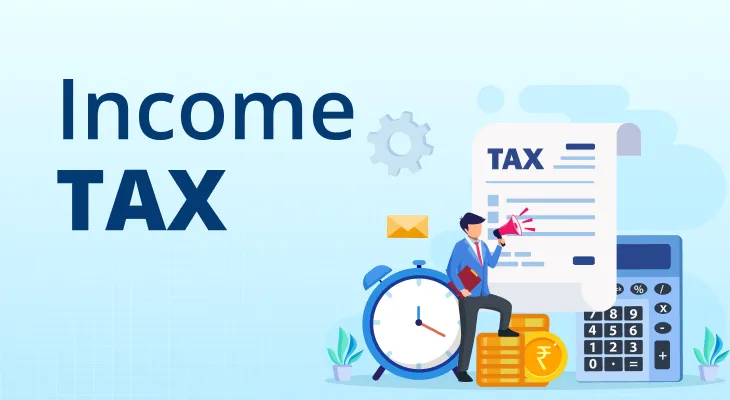
Income Tax Act
The Income Tax Act of 1961 (ITA) is a comprehensive legal structure that covers all elements related to income tax. It includes defining what counts as income, setting tax rates, and outlining how taxes are calculated. As an Indian taxpayer, you frequently engage with this Act, though it can be a bit complex to comprehend. In this blog, we'll explain how the Income Tax Act works for individuals, the rules it has, its connection with the Finance Act, and the impact of government notifications and circulars. We'll also explore the Finance Act in detail, discussing recent changes to income tax slabs. If you wish to know about the differences between the new and old tax rules, this guide is here to offer support.
Understanding the Income Tax Act
The Income Tax Act of 1961 is the central set of rules that control how income tax works in India. It outlines the provisions that govern the evaluation, computation, and collection of income tax. This Act applies to everyone, including individuals, companies, and other entities generating income within India. The money you earn could come from diverse sources such as salary, business profits, speculative income, or capital gains. In essence, if you're earning money, then the Income Tax Act in India affects you.
Income Tax Rules, 1962
Operating in combination with the Income Tax Act are the Income Tax Rules, 1962. These rules provide detailed guidelines on translating the Act's provisions into practical application. They serve as a comprehensive guide, offering insights into tax computations, allowable deductions, exemptions, and various aspects of adhering to tax rules. These rules act as a roadmap, ensuring both taxpayers and tax authorities follow a standardised route during tax proceedings.
Finance Act
The Finance Act is closely connected to the Income Tax Act. Every year, the Finance Bill is presented to Parliament as an integral component of the Union Budget. This Bill gives life to the financial proposals outlined in the budget and introduces modifications to various tax laws, including the Income Tax Act. It's like an annual update that shapes the financial landscape.
The amendments introduced through the Finance Bill can substantially influence your tax liabilities, deductions, and overall financial planning. Before it becomes law, both the Lok Sabha and Rajya Sabha can suggest alterations and modifications to this bill. Once it's approved by both houses of Parliament, it needs to receive the President's approval to transform into the Finance Act.
Judicial Announcements
Judicial decisions play a significant role in interpreting the provisions of the Income Tax Act in India. Court rulings establish precedents that guide future cases, ensuring uniformity and equity in tax matters. These decisions not only provide clarity on complex sections of the act but also help understand what the lawmakers intended. Staying updated about these judicial announcements can offer useful insights when dealing with tax-related disputes.
Government Notifications and Circulars
Apart from court rulings, the government issues official notifications and circulars that provide additional explanations for different parts of the Income Tax Act. These notifications and circulars come from the Ministry of Finance and the Central Board of Direct Taxes (CBDT). These notifications serve as official interpretations, helping taxpayers and tax professionals understand what the act's rules mean in practical terms. Whether it's the introduction of a new tax deduction or an extension of a deadline, these notifications ensure you're well-informed.
Overview of the Finance Act
The Finance Act of 2023 has introduced several alterations to the Income Tax Act. Some of the noteworthy changes include:
The introduction of a fresh tax regime featuring reduced tax rates.
A rise in the standard deduction allowed for individuals with salaried income.
The introduction of a fresh tax deduction aimed at individuals who invest in long-term equity mutual funds.
An augmentation in the surcharge and cess on income tax. Income Tax Slabs and Tax Rates
Here is a glimpse of the new income tax slabs and tax rates for individuals who are not claiming deductions (new regime)
| Tax Slabs | Income-tax Rates |
|---|---|
| Up to ₹3 lakh | Nil |
| ₹3 lakh - 6 lakh | 5% |
| ₹6 lakh - 9 lakh | 10% |
| ₹9 lakh - 12 lakh | 15% |
Choosing between New and Old Tax Regimes
The Finance Act of 2023 has implemented a fresh tax regime distinguished by its lower tax rates. Within this new framework, the highest tax rate stands at 30%, as opposed to the former 35% prevalent in the old regime. However, opting for the new regime entails forfeiting certain deductions and exemptions. For those who prefer an alternative approach, the old tax regime remains available.
Understanding Permanent Account Number (PAN)
Comprising ten alphanumeric characters, the PAN number is vital for filing tax returns, conducting financial transactions, and even opening a bank account. Your PAN functions as a record of your financial transactions, highlighting its significance in maintaining financial transparency.
Conclusion
Amid the complex world of taxes, the Income Tax Act serves as a guiding light, showing the way toward responsible financial citizenship. With its complex set of rules and regulations, this act guides your money decisions, defines your tax duties, and contributes to the country's progress. The Income Tax Act is a complex law and taxpayers need to understand their tax obligations.
As you move through your financial journey, keep in mind to stay updated about the changes brought by the Finance Act and be aware of government notifications. Comprehending the complexities of the Income Tax Act allows you to navigate the financial realm while fulfilling the established regulations.
FAQ
How does the Income Tax Act apply to different income sources?
The scope of the Income Tax Act extends across a wide range of income sources, including salaries, business profits, capital gains, and more. This comprehensive legislation covers individuals, corporations, and entities that generate income within the geographical boundaries of India.
What implications do the new and old tax regimes have on specific deductions?
Opting for a tax regime involves trade-offs. The New Tax Regime offers lower rates but limited deductions, while the Old Tax Regime features higher rates with a broader range of deductions.
What are the practical differences between a PAN and an Aadhaar Card Number?
Although both are unique identifiers, PAN is primarily for income tax-related transactions, whereas an Aadhaar card number has a broader scope and is issued by the government for various purposes, including social welfare schemes.
How can I stay updated about any changes introduced through the Finance Act?
Staying informed is essential. Regularly monitor government websites, trusted financial news outlets, and credible tax advisory sources for updates on amendments, circulars, and notifications. This ensures you're well-equipped to adapt to changes affecting your tax planning and compliance.
Can government notifications and circulars change the tax implications of an existing provision in the Income Tax Act?
Yes. Government notifications and circulars can provide additional guidance or interpretations on existing provisions of the Income Tax Act. These can impact the way a specific provision is applied or understood for practical purposes.


